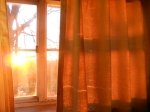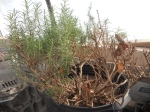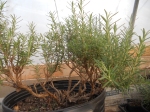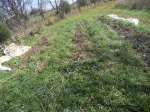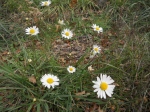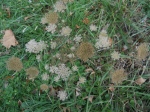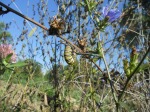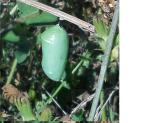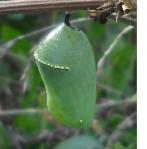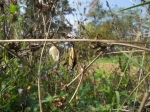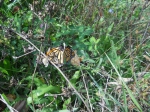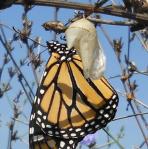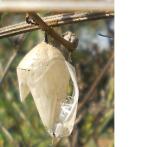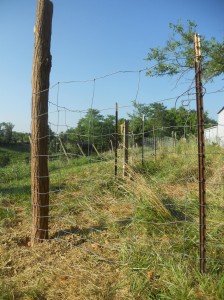You are currently browsing the category archive for the ‘A Present from God’ category.
Readers, just make allowance: Fall garden-keeping is undramatic, and on the drab side, image-wise. On the other hand, it is restful: sometimes the plants seem as ready for dormancy as we are.
On the other hand, there is always beauty for those who look. Thank you for seeing!
- Grateful for the light: looks like a work day!
- Greenhouse sadly neglected, including this drought-damaged Rosemary
- But it takes so little to restore healthy life!
- Hateful job, clearing tomato vines, untangling ties & trellises, row by row…
- … the reward: somehow this Monarch chrysalis avoided being trampled during a long tomato season
- One of my best Squash seasons ever, ends honorably for the stout, productive vines.
- Daisies in November… strange but still lovely…
- ….and not a yard away, Queen Anne’s own pattern of fading loveliness
- Monarch caterpillar, hanging from a stout chicory stem, prepares to become a pupa
- Later it relaxes to a J-shape
- I don’t check till 6pm: here’s the safely encased new pupa
- Pupation should take 9-14 days: it’s Day 11, and I worry…
- 11 more days pass. I’ve given up hope. Then, morning, Day 23…
- Slowly the soft new wings fan open and shut
- The next best thing to seeing emergence: a strong new butterfly!
- Can you spot the Monarch, among the bright Ash leaves?
- fragile symbol of new life
Bear with me, there’s some history here.
Last Winter my does had four sets of triplets, one of quadruplets and three of twins. A fine crop, but not without losses.
The saddest was Edie #27, who lost all three: one, a huge buck, was born dead and the other two were compromised by delayed labor. Thin and subdued, she’s still been a devoted aunt to Aggie’s three. On Genia’s advice, this year I am feeding less grain, which should (has, so far) reduce both multiples and birth size.
In March, a cheering visit from my newest apprentice goatherd, Alaina.
Including some practice in rounding up young Spock, who had successfully challenged his pen and, out among the flock, was showing interest in poor bereaved Edie. Who was, surprisingly, showing interest in him.
He hasn’t been out again since Steve’s last job of reinforcement. And “poor Edie” regained appetite, weight and spirits. Well, yeah…
Then around August 1, she started filling her udder. And the timing (150 +/- days) was just about right.
Last evening, Jess put in a wearying hour helping get her into a kidding stall, with an alarmingly distended udder. At 6 AM, there were 2012’s newest lives, two lively, but quiet girls, like their sweet mother.
After my last post, I hope the point(s) are clear: rewards, sometimes unplanned for, if not totally unexpected: and support, help and friendship.
…for us and the bees.
I spend the entire Summer explaining “pruning,” instead of pinching, Basil. “Pruning” means cutting off the whole stem, so the plant keeps branching – not pulling off single leaves here and there, which robs the plant of nutrition without stimulating new growth. When the side shoots are this size, prune them the same way. See below. You’re welcome. A public service.
Next, progress, more progress, fun and fellowship.
- See the third set of leaves above the soil ? That’s where to prune.
- My niece and great niece sharing some enjoyment and labor
- Cherry tomatoes, all trellised
- The sauce tomatoes have a good start
- The blessing of rain allowed for a good thorough hoeing
- Finally all sprouted and growing
- Already, iIn the tiniest pod, the beans are visibly forming
- Buckwheat is flourishing and bees have found it
- … and are harvesting
- Young workers are drawing comb on three frames of their new medium
- The hive mother, on the last of the deep frames to be filled with brood
- A healthy Hyacinth and the first little Moose
- Cold day, warm family
- The girls are now happily settled with Sue’s flock.
She was the best. That’s all I can say right now. See previous post for history.
Three years ago my friend (and occasional barn/fence/tractor carpenter/mechanic) Steve announced, to everyone’s delight, that he had set up 2 beehives in his City yard. I’ve been following his learning process, progress and setbacks with the same concern he brings to mine with goats.
Bees have fascinated me since age 5. Mother handled all encounters with Nature alike: “You mustn’t get mad at the bee.” It was afraid of me, I had stepped on it, and it died from stinging – to a child’s mind, terribly unfair. Then the 1958 National Geographic with those incredible closeups. And one day in the woods, not long before my family left Columbia Station for Cleveland Heights, a sound like a tractor from the edge of a field where no tractor should be, and a swarm the size of a soccer ball weighting down a large maple limb.
In 1988 when I found the ravines here lined with Black Locust trees, heavy in Spring with creamcolored blossoms and honey fragrance, beehives were a logical thought. But something else always came first. The way horses and dogs accumulated was a caution. I resisted turning into one of those nut-job rural outfits with peacocks, llamas, potbellied pigs and a mud lawn. Goats were a sound investment for the terrain, but more lives to be responsible for.
4 years and 3 kidding seasons in, the goats are settled. Down to 3 horses and 2 dogs, the day’s rhythm is sustainable even in weather extremes. So early this Spring, when a stack of old hive boxes turned up in the cellar of an abandoned house nearby, it seemed like time to add 1 new species to my cares.
My old 3-bay Central Compost Facility moved to the barnyard, leaving a space down out of the wind, open to the East but shaded at midday by a dozen locust trees. Bees would have a clear flight path out over the valley to the ravine and pond. The spot gets early sunrise, never suffers in drought, and in locust bloom season, looks like a heavy snow.
“Everything will happen faster than you expect,” goes a maxim in technology. Who would have thought, after the sunny day I spent scraping and priming those old hives, that an excited call from Alaina would announce that they had captured a swarm in their yard, and that Steve would be bringing it the next day?
- Early Winter light over the Bee Yard-to-be
- Soon to open, filling the air with honey scent – and the bees with nectar!
- One of last year’s “walls of blossom” – a job going begging for pollinators
- The wild cherry trees add a contribution
- A promise in buds of the wild apple trees that spring up all over
So a heavy (3 lb), vigorous colony settled into a loaner hive, till the paint dries on my recycles. Then, when these tireless urban beekeepers saw the potential in locust bloom, two more hives from their backyard arrived. One has a honey super, so there may even be some pale, delicate Spring honey to reward them for scrambling to make this happen. For me, reward enough, 3 or 4 times daily, to observe the coming and going, the colors of pollen, the change in sounds as they respond to a scout message, or settle for the night.
When the camera is back from repair, I’ll let you see the Bee Yard in its lovely setting. For now, some archive images of what the foragers have been finding. More about Steve & Alaina’s beekeeping in all its trials, successes and beauty, at http://pasztphoto.smugmug.com/Other/Bees/12270969_NqhDFb#!i=875419354&k=ZbC2b
It gets involved…. Last season (if you check Seasonal Reflections, posts headed “Kidding 2011”) my does were birthing from Dec 27 thru March 24. Determined not to stretch it out that far again, I planned to begin turning them in with Nobel as soon as any of them cycled, beginning in mid-August. (They may cycle in July or earlier, but I didn’t want a repeat of the 14-degree day in December when Jonquil, Hyacinth and Columbine unexpectedly produced 2 sets of twins and one of triplets!)
Meanwhile I checked with Goat-Raising Mentors Larry & Genia about the best way to go about selling Nobel. I’m keeping 2 of his daughters, so I’ll need an outcross buck for next season. But since I didn’t keep any from ’10, I have gotten a very satisfactory 3 seasons’ use of him.*
The reply, out of the blue, was that (after an unsatisfactory first season, both in number and quality of kids) they had sold their buck to a neighbor for ground-clearing use, and needed one for this season. Aaack! Would he be able to get 8 does covered by Sept 15? He would darn sure try.
I did not reckon on swirling cross-currents of goat fertility. Nine does (including Trill, whom I did not plan to breed this Fall, so that I could have milk thru Winter – what a treat!) all cycled in the space of about 10 days. What I also did not count on was the power of the breeding motivation in a full-grown buck goat. The effect of, apparently, a dense low-hanging cloud of caprine estrogen was to turn placid, biddable Nobel into a cunning and heedless weapon of barn destruction.
5 of the 9 are “people goats,” friendly and broke to lead, associating it with pleasant recollections of milking, extra grain, being extricated from fence, etc. 4 others, docile enough, just don’t make a connection between a hand on their collar and anything positive. It is especially difficult to convince a full-grown doe who has been hanging around the barnyard, sidling along the fence nearest the buck’s stall, twitching her tail and bleating longingly, that to be led away from the fence, through two stall doors and the barn aisle, will shortly give her access to the same buck. Difficult? By myself, impossible.
Complicate this with the same buck, butting his full-grown horns against (very often through) barn siding, stall partitions, stall gates and reinforced stock panels, and trying to climb or jump newly installed fence, to reach the same doe. This led to some scary moments, mostly here by myself, when he was out of his stall, ranging freely thru the barn and pens adjacent to the does, and “challenging” (up on hind legs) at any effort to corral him.
Thanks to neighbors (geographical or cultural – we here define “neighbor” pretty widely) RK, Kayla, Leslie, Steve, Polly and John for the extra hands, and the fact that yesterday, I was able to assure Larry that all were covered, and that he was welcome to take Nobel off to his “second shift” with 20-odd does at Windhover Farm.
*6 kids for 4 does in ’10, 14 for 6 in ’11, and stay tuned for Kidding ’12. I’ve told Larry that if they all kid in one week in January, he can come out and help. He says OK.
This left a little time for some other aspects of life: more mowing, more gardening, my Mother’s 99th birthday party, and a few encounters with creatures at least as interesting, if not quite as “challenging” as goats.
- To my satisfaction at his good new home, but loss of what I have to call a friend: an asset to my farm and a symbol of finding the nerve to commit to a full breeding flock.
- Steep and brushy hillside of the big field, which I can only face for a few rows before wimping off to easier terrain.
- The second planting of Summer Squash begins to yield – here, Gold Bar zucchini, from Nichols, the most productive and reliable yellow zucchini of many I’ve tried.
- Lovely bright blossoms on a fine stand of Cowpeas from Vermont Bean
- Cherry Tomato tart for Labor Day fellowship with Pam, Steve, Charleigh and Poppaw
- From the day I ditched Market to field other social and farm issues: those unsold San Marzanos became 6 jars of roasted Tomato/Garlic sauce
- …an estivating Box Turtle in the shady, muddy hollow above the spring
- … a female Carolina Mantis (our native Mantis)… hoping to catch a hummingbird? You think?
- … a fine Black & Yellow Argiope, the most helpfully voracious Garden Spider, here controlling leafhoppers in the shed yard. Oh well…
- Okay, “just” a honeybee, in honor of my learning that Sunflowers are actually a good nectar source (thanks Beekeeper Steve). Do please click for closeup of incredible texture of disc flowers!
- This large and striking Dryad’s Saddle appears several times a year at the roots of a big Water Maple. If I can get an expert to confirm its edibility, I’ll let you all know how it tastes.
- …years, that is, not candles: Mom celebrates with help from youngest Great-Grand, Will
To recent visitors: the title refers to a method of keeping track of tasks for the week, and imposing a little order on the kitchen table, where all the unwanted paper coming into the house winds up. To long-time guests: no. This has not helped to keep the table clear. They keep sending more.
Week July 21:
Sun: water: sow parsnips; repot rosemary; store Garlic
Mon: cool? Steve to build buck pen & bushhog; till T-2: prune Basil: level M-7, sow Fall greens: strip Basil
Tues: AM, level T-2 : Basil to Tricia’s; pick up masa; PM set sweet potatoes, peppers, late eggplant
Wed: AM: water: to Mother’s; PM -Turner Farm, tortilla WS
Thurs: haul water; water; set sp’s & ep’s
Fri: Market prep
A break from the heat (90, i/0 94) let us work on the buck’s pen, so he can be left out for a while. Some sorry hired work last year left sags and gaps, tempting to a determined Nobel, when there are does in heat. Last season, kidding ran from December 27 to March 23, making it time-consuming and fraught with worry. This year instead of letting him run with the flock, I will turn each doe in with him when she’s cycling. Being sure when she’s covered will let me plan for kidding, and (I hope) target for a shorter period.

Hard work plus a lot of sweat: a stout new corner to Nobel's pen. Wish the picture showed how that post is set 32" in the ground!
It’s not finished: the morning was taken up by some catchup barn carpentry – oh heck, not to put too fine a point on it, having to nail back a section of siding that Nobel managed to butt loose in an escape plot. But one more solid post like the one at left, and we can place a single tight stretch of woven wire that he’s less likely to challenge. If it takes a whole morning next week, Steve may at least have an afternoon to get on the tractor!
This Present from God appeared while raking rows for chile peppers in plot T-2. I suppose I should have killed it – the caterpillars have been destructive this year – but by morning light it seemed just a mother fulfilling her duty to her kind. Anyway from her condition I judged the eggs were already laid!
That’s what we call it when you are in the right placeat the right time for an observation of Nature that you’d otherwise miss.
Today coming back from Trip IV with hay for the horses and pine for the goats, I heard a deafening chatter from the hackberry trees along the barn lane. A flock of robins (they only congregate in cold weather, either migrating or converging on a food supply) were taking advantage of the trees’ fruit. They stayed 2 or 3 hours,, and aren’t going to leave much of the small, seedy, astringent fruit. So despite damp boots (Rule #1, in a way of life with few hard and fast rules, is Get Out of the Wet Socks) I grabbed my new Nikon Coolpix, which I’ve yet to master thoroughly after a week, and got these.

